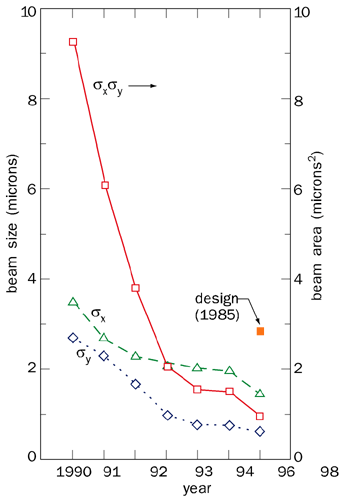The Stanford Linear Collider has generated its last Z particle unless the US government provides more money. But it crowned its act with a flourish.

Just before noon on 8 June, operators at the Stanford Linear Accelerator Center (SLAC) shut down the SLC Stanford Linear Collider for what may have been the last time.
It had been a record-breaking year-long run in which the world’s first-ever linear collider more than tripled its collision rate, or luminosity, and generated over 350,000 massive Z particles for physicists on the SLD experiment collaboration to study. But unless the US Department of Energy provides the funding for an extension, the 199798 run will have been the SLC’s last hurrah.
The data-taking phase of the run had begun slowly in July 1997. Although the peak luminosity matched that of prior years, it was not quite up to the levels of the 1996 run. Accelerator physicists and operators were taking extra time to tune the machine carefully in preparation for the long run.
In October and November the collider really hit its stride, however, often exceeding a hundred hours of successful operations and 10, 000 Zs per week. After recovering from the Christmas shutdown, the machine surpassed even those levels, occasionally delivering over 20,000 Zs per week during the rest of the run.
Under the leadership of Nan Phinney, who was aided by the untiring efforts of Pantaleo Raimondi and Tracy Usher, the SLC performed beyond expectations. Often working through the night, this pair found clever solutions to long-standing problems and helped achieve large luminosity gains without any major hardware upgrades.
With beam profiles at the interaction point as small as 0.65 by 1.5 microns (rms half height and width), physicists finally began to observe the long-awaited phenomenon of “disruption”, in which a bunch is compressed by the macroscopic electromagnetic fields of the bunch it passes through. According to estimates, this enhancement doubled the peak luminosity, leading to the high values attained toward the end of the run. Experimenters marvelled at occasional events in which they could clearly discern the crossing of two Zs produced in a single bunch.
The collider was roaring along, generating 5300 Zs in the previous 24 hours, when a vacuum failure in the positron source forced its premature shutdown a week early. At the time the SLC was spewing out about 300 Zs per hour, or a peak luminosity of about 3×1030 per sq cm per s half its design value.
The number of Zs the SLC produced in the 199798 run is nearly twice that generated in all previous runs, bringing the cumulative total to more than half a million. When combined with electron beam polarization levels of 73%, this bonanza means that SLD physicists will have plenty of work in the coming months extracting the world’s best measurement of the weak mixing angle. And using the SLC’s narrow beams together with what is the world’s most sophisticated vertex detector, the collaboration may also be able to uncover other unique physics results such as measuring the mass difference that determines the frequency of particle-antiparticle mixing in Bs mesons.
Undoubtedly there will be important questions left unanswered, however, and collaboration leaders are already lobbying for a final SLC run to raise the total number of Zs to more than a million. Another run could also allow them to boost its peak luminosity above the design value to 1031, Phinney estimates. Such an achievement would help advance the state of the linear collider art in preparation for the TeV-scale linear collider that many now agree is the next major project for high-energy physics.
Whatever else happens, the SLC will go down in history as the machine that proved the feasibility of the linear collider concept. Although outgunned by CERN’s LEP collider ring in terms of the sheer output of Z particles, physicists at SLAC fought back successfully by emphasizing narrow beams and polarization as important tools for doing precision physics measurements. With nearly twice the beam polarization originally planned, the SLC has now essentially achieved the overall performance goals set for it more than a decade ago despite falling a bit short on the luminosity front. And even that shortcoming could be erased in a final run.








